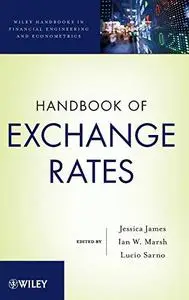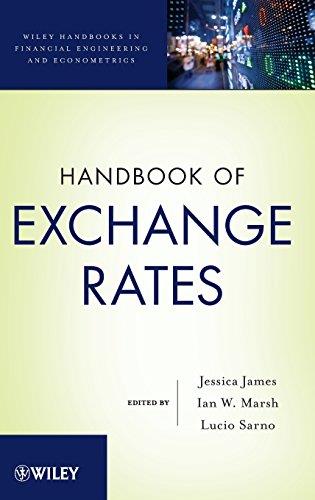Handbook of Exchange Rates By
2012 | 830 Pages | ISBN: 0470768835 | PDF | 8 MB
2012 | 830 Pages | ISBN: 0470768835 | PDF | 8 MB
Praise for Handbook of Exchange Rates“This book is remarkable. I expect it to become the anchor reference for people working in the foreign exchange field.”?Richard K. Lyons, Dean and Professor of Finance, Haas School of Business, University of California Berkeley“It is quite easily the most wide ranging treaty of expertise on the forex market I have ever come across. I will be keeping a copy close to my fingertips.”?Jim O’Neill, Chairman, Goldman Sachs Asset ManagementHow should we evaluate the forecasting power of models? What are appropriate loss functions for major market participants? Is the exchange rate the only means of adjustment? Handbook of Exchange Rates answers these questions and many more, equipping readers with the relevant concepts and policies for working in today’s international economic climate.Featuring contributions written by leading specialists from the global financial arena, this handbook provides a collection of original ideas on foreign exchange (FX) rates in four succinct sections:• Overview introduces the history of the FX market and exchange rate regimes, discussing key instruments in the trading environment as well as macro and micro approaches to FX determination.• Exchange Rate Models and Methods focuses on forecasting exchange rates, featuring methodological contributions on the statistical methods for evaluating forecast performance, parity relationships, fair value models, and flow–based models.• FX Markets and Products outlines active currency management, currency hedging, hedge accounting; high frequency and algorithmic trading in FX; and FX strategy-based products.• FX Markets and Policy explores the current policies in place in global markets and presents a framework for analyzing financial crises.Throughout the book, topics are explored in-depth alongside their founding principles. Each chapter uses real-world examples from the financial industry and concludes with a summary that outlines key points and concepts.Handbook of Exchange Rates is an essential reference for fund managers and investors as well as practitioners and researchers working in finance, banking, business, and econometrics. The book also serves as a valuable supplement for courses on economics, business, and international finance at the upper-undergraduate and graduate levels.Content: Chapter 1 Foreign Exchange Market Structure, Players, and Evolution (pages 1–44): Michael R. King, Carol Osler and Dagfinn RimeChapter 2 Macro Approaches to Foreign Exchange Determination (pages 45–71): Menzie ChinnChapter 3 Micro Approaches to Foreign Exchange Determination (pages 73–110): Martin D. D. Evans and Dagfinn RimeChapter 4 The Exchange Rate in a Behavioral Finance Framework (pages 111–132): Paul De Grauwe and Pablo Rovira KaltwasserChapter 5 The Evolution of Exchange Rate Regimes and Some Future Perspectives (pages 133–158): Paul R. MassonChapter 6 Purchasing Power Parity in Economic History (pages 159–187): Lawrence H. OfficerChapter 7 Purchasing Power Parity in Tradable Goods (pages 189–220): Ian W. Marsh, Evgenia Passari and Lucio SarnoChapter 8 Statistical and Economic Methods for Evaluating Exchange Rate Predictability (pages 221–263): Pasquale Della Corte and Ilias TsiakasChapter 9 When Are Pooled Panel?Data Regression Forecasts of Exchange Rates More Accurate than the Time?Series Regression Forecasts? (pages 265–281): Nelson Mark and Donggyu SulChapter 10 Carry Trades and Risk (pages 283–312): Craig BurnsideChapter 11 Currency Fair Value Models (pages 313–342): Gino Cenedese and Thomas StolperChapter 12 Technical Analysis in the Foreign Exchange Market (pages 343–373): Christopher J. Neely and Paul A. WellerChapter 13 Modeling Exchange Rates with Incomplete Information (pages 375–390): Philippe Bacchetta and Eric van WincoopChapter 14 Exchange Rates in a Stochastic Discount Factor Framework (pages 391–420): Hanno Lustig and Adrien VerdelhanChapter 15 Volatility and Correlation Timing in Active Currency Management (pages 421–447): Pasquale Della Corte, Lucio Sarno and Ilias TsiakasChapter 16 Active Currency Management Part I: Is There a Premium for Currency Investing (Beta) (pages 451–469): Geoffrey Kendrick and Saeed AmenChapter 17 Active Currency Management Part II: Is There Skill or Alpha in Currency Investing? (pages 471–501): Richard M. Levich and Momtchil PojarlievChapter 18 Currency Hedging for International Bond and Equity Investors (pages 503–543): Kristjan KasikovChapter 19 FX Reserve Management (pages 545–561): Michael J. PaulusChapter 20 High Frequency Finance: Using Scaling Laws to Build Trading Models (pages 563–584): Alexandre Dupuis and Richard B. OlsenChapter 21 Algorithmic Execution in Foreign Exchange (pages 585–597): James E. DaltonChapter 22 Foreign Exchange Strategy Based Products (pages 599–621): Aysu SecmenChapter 23 Foreign Exchange Futures, Forwards, and Swaps (pages 623–645): Naohiko Baba, Yuji Sakurai and Frank PackerChapter 24 FX Options and Volatility Derivatives: An Overview from the Buy?Side Perspective (pages 647–696): Oleg SvirschiChapter 25 A Common Framework for Thinking about Currency Crises (pages 697–716): Robert Flood, Nancy Marion and Juan Yepez AlbornozChapter 26 Official Intervention in the Foreign Exchange Market (pages 717–749): Marcel FratzscherChapter 27 Exchange Rate Misalignment—The Case of the Chinese Renminbi (pages 751–765): Yin?Wong CheungChapter 28 Choosing an Exchange Rate Regime (pages 767–784): Jeffrey A. Frankel



